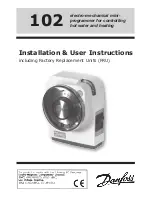
DocID018909 Rev 11
RM0090
Ethernet (ETH): media access control (MAC) with DMA controller
1232
always accessed in the maximum possible burst size (limited by PBL) for the 16 bytes to be
read.
The Transmit DMA initiates a data transfer only when there is sufficient space in the
Transmit FIFO to accommodate the configured burst or the number of bytes until the end of
frame (when it is less than the configured burst length). The DMA indicates the start address
and the number of transfers required to the AHB Master Interface. When the AHB Interface
is configured for fixed-length burst, then it transfers data using the best combination of
INCR4, INCR8, INCR16 and SINGLE transactions. Otherwise (no fixed-length burst), it
transfers data using INCR (undefined length) and SINGLE transactions.
The Receive DMA initiates a data transfer only when sufficient data for the configured burst
is available in Receive FIFO or when the end of frame (when it is less than the configured
burst length) is detected in the Receive FIFO. The DMA indicates the start address and the
number of transfers required to the AHB master interface. When the AHB interface is
configured for fixed-length burst, then it transfers data using the best combination of INCR4,
INCR8, INCR16 and SINGLE transactions. If the end of frame is reached before the fixed-
burst ends on the AHB interface, then dummy transfers are performed in order to complete
the fixed-length burst. Otherwise (FB bit in ETH_DMABMR is reset), it transfers data using
INCR (undefined length) and SINGLE transactions.
When the AHB interface is configured for address-aligned beats, both DMA engines ensure
that the first burst transfer the AHB initiates is less than or equal to the size of the configured
PBL. Thus, all subsequent beats start at an address that is aligned to the configured PBL.
The DMA can only align the address for beats up to size 16 (for PBL > 16), because the
AHB interface does not support more than INCR16.
33.6.3
Host data buffer alignment
The transmit and receive data buffers do not have any restrictions on start address
alignment. In our system with 32-bit memory, the start address for the buffers can be aligned
to any of the four bytes. However, the DMA always initiates transfers with address aligned to
the bus width with dummy data for the byte lanes not required. This typically happens during
the transfer of the beginning or end of an Ethernet frame.
•
Example of buffer read:
If the Transmit buffer address is 0x0000 0FF2, and 15 bytes need to be transferred,
then the DMA will read five full words from address 0x0000 0FF0, but when transferring
data to the Transmit FIFO, the extra bytes (the first two bytes) will be dropped or
ignored. Similarly, the last 3 bytes of the last transfer will also be ignored. The DMA
always ensures it transfers a full 32-bit data items to the Transmit FIFO, unless it is the
end of frame.
•
Example of buffer write:
If the Receive buffer address is 0x0000 0FF2, and 16 bytes of a received frame need to
be transferred, then the DMA will write five full 32-bit data items from address
0x0000 0FF0. But the first 2 bytes of the first transfer and the last 2 bytes of the third
transfer will have dummy data.
33.6.4 Buffer
size
calculations
The DMA does not update the size fields in the transmit and receive descriptors. The DMA
updates only the status fields (xDES0) of the descriptors. The driver has to calculate the
sizes. The transmit DMA transfers the exact number of bytes (indicated by buffer size field in
TDES1) towards the MAC core. If a descriptor is marked as first (FS bit in TDES0 is set),
















































